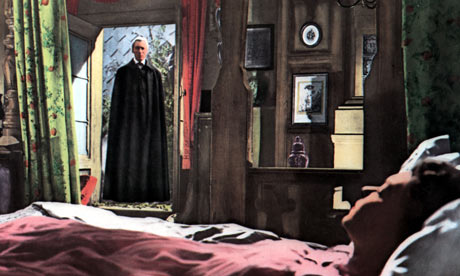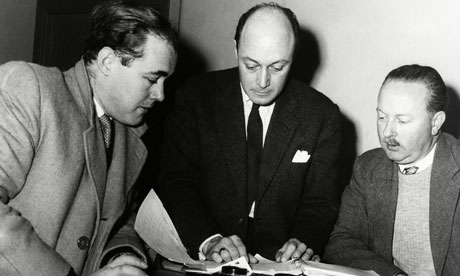
Christopher Lee in Dracula (1958). Jimmy Sangster's script reused the template of his earlier Hammer film The Curse of Frankenstein.
In 1957, Hammer Films revived gothic horror – in abeyance in a decade which offered nuclear or cosmic horrors that made the classic monsters seem tame – with The Curse of Frankenstein, directed by Terence Fisher and starring Peter Cushing and Christopher Lee. To hear him tell it, Jimmy Sangster, who has died aged 83, wrote the script because no one else would, and simply typed it out and turned it in.
Yet Sangster came up with a new story – owing as little to Mary Shelley's novel as to James Whale's earlier film – and a radical depiction of Frankenstein as a determined, charming yet corrupt dandy who could still chill in an era of nuclear proliferation. Sexually amoral (he uses his monster to murder the maid he has impregnated), rigidly dividing his life (making a bloody hash in the laboratory; prissily refined at the breakfast table) and intent on his "higher calling", this Victor Frankenstein was as ruthless, fascinating and yet remote as the social climber of Room at the Top or the early James Bond.
The same team – Sangster included – then created the even more successful Dracula (1958). Sensing a formula which worked, or in a hurry, Sangster reused the template of The Curse of Frankenstein: Cushing's visionary character is repeatedly thwarted by the ineptitude and small-mindedness of everyone around him, although here Cushing is Dr Van Helsing, and his goal is not the creation of Lee but his destruction, with Lee cast as an unprecedentedly active, virile Dracula.
 Jimmy Sangster, left, discusses his script for Intent to Kill (1958) with the director Jack Cardiff and the producer Adrian Worker.
Jimmy Sangster, left, discusses his script for Intent to Kill (1958) with the director Jack Cardiff and the producer Adrian Worker.
Yet Sangster came up with a new story – owing as little to Mary Shelley's novel as to James Whale's earlier film – and a radical depiction of Frankenstein as a determined, charming yet corrupt dandy who could still chill in an era of nuclear proliferation. Sexually amoral (he uses his monster to murder the maid he has impregnated), rigidly dividing his life (making a bloody hash in the laboratory; prissily refined at the breakfast table) and intent on his "higher calling", this Victor Frankenstein was as ruthless, fascinating and yet remote as the social climber of Room at the Top or the early James Bond.
The same team – Sangster included – then created the even more successful Dracula (1958). Sensing a formula which worked, or in a hurry, Sangster reused the template of The Curse of Frankenstein: Cushing's visionary character is repeatedly thwarted by the ineptitude and small-mindedness of everyone around him, although here Cushing is Dr Van Helsing, and his goal is not the creation of Lee but his destruction, with Lee cast as an unprecedentedly active, virile Dracula.
 Jimmy Sangster, left, discusses his script for Intent to Kill (1958) with the director Jack Cardiff and the producer Adrian Worker.
Jimmy Sangster, left, discusses his script for Intent to Kill (1958) with the director Jack Cardiff and the producer Adrian Worker. These two credits alone would establish Sangster as a major creator, though he often professed little interest in the gothic, and was more taken with putting together twist-driven thrillers such as Intent to Kill (1958), directed by Jack Cardiff. He wrote The Revenge of Frankenstein (1958), The Mummy (1959), The Brides of Dracula (1960) and other Hammer gothics, but handed over his spec script Taste of Fear (1961) only on the condition that he be allowed to produce. As writer-producer, he specialised in psychological crime, most notably in the Oliver Reed melodrama Paranoiac (1963) and the Bette Davis vehicle The Nanny (1965).
When Hammer wanted to remake The Curse of Frankenstein, Sangster impulsively agreed to write it if he were also allowed to direct. The Horror of Frankenstein (1970) isn't a terribly good black comedy, and Sangster was similarly deprecating about Lust for a Vampire (1971), a troubled production he helmed when his old colleague Terence Fisher was sidelined by a road accident. The suspense movie Fear in the Night (1972) is his best work as director.
He was born James Henry Kinmel Sangster in Kinmel Bay, north Wales. His estate agent father was persuaded to put in the town's name because he was supposedly the first baby born there. He was educated at Ewell Castle school, in Surrey, and entered the British film industry at 16 as a production assistant. After service with the RAF, he worked at a third assistant director on Ealing Studios productions (The Captive Heart, Pink String and Sealing Wax). He joined Exclusive Studios, which would become Hammer Films, in 1949, and worked as assistant director and production manager on many of the B-pictures the studio turned out before gaining success and prominence in horror.
His first script was for a short (A Man On the Beach, 1955) and his first feature script was X the Unknown (1956), a science-fiction film planned as an entry in Hammer's Quatermass series until Nigel Kneale refused permission to use the character. In the late 1950s and early 60s, other companies imitated Hammer. The producer-directors Robert Baker and Monty Berman hired Sangster to write historical horrors (Jack the Ripper, 1959), a science-fiction film (The Trollenberg Terror, 1958) and even the based-on-fact drama The Siege of Sidney Street (1960), in which Sangster appears in a non-speaking role as Winston Churchill, puffing a cigar and ducking bullets during the climactic siege.
Private I, his first novel, was published in 1967, and adapted as an American TV movie (The Spy Killer) in 1969. This led to more work in American TV, as story editor or scriptwriter on shows such as Banacek and Wonder Woman. He contributed supernatural scripts to Kolchak: The Night Stalker and the anthology show Ghost Story. Though retired from the late 80s, a shelved Sangster script was filmed in Germany as Flashback in 2000. His memoirs (Do You Want It Good Or Tuesday? was the characteristic title) were published in 1997. In recent years, he recorded DVD commentaries in which he affected surprise that anyone would be interested in his work. The screenwriter Peter Atkins describes him as "a very self-effacing writer who was better than he thought he was and who gave all of us, I think, moments of genuine pleasure with his work".
He was married to Monica, a hairdresser on the early Hammer films, from 1950 to 1968; they had a son, James. He is survived by his second wife, the actor Mary Peach, and his son.
• James Henry Kinmel Sangster, screenwriter, producer, director and novelist, born 2 December 1927; died 19 August 2011
When Hammer wanted to remake The Curse of Frankenstein, Sangster impulsively agreed to write it if he were also allowed to direct. The Horror of Frankenstein (1970) isn't a terribly good black comedy, and Sangster was similarly deprecating about Lust for a Vampire (1971), a troubled production he helmed when his old colleague Terence Fisher was sidelined by a road accident. The suspense movie Fear in the Night (1972) is his best work as director.
He was born James Henry Kinmel Sangster in Kinmel Bay, north Wales. His estate agent father was persuaded to put in the town's name because he was supposedly the first baby born there. He was educated at Ewell Castle school, in Surrey, and entered the British film industry at 16 as a production assistant. After service with the RAF, he worked at a third assistant director on Ealing Studios productions (The Captive Heart, Pink String and Sealing Wax). He joined Exclusive Studios, which would become Hammer Films, in 1949, and worked as assistant director and production manager on many of the B-pictures the studio turned out before gaining success and prominence in horror.
His first script was for a short (A Man On the Beach, 1955) and his first feature script was X the Unknown (1956), a science-fiction film planned as an entry in Hammer's Quatermass series until Nigel Kneale refused permission to use the character. In the late 1950s and early 60s, other companies imitated Hammer. The producer-directors Robert Baker and Monty Berman hired Sangster to write historical horrors (Jack the Ripper, 1959), a science-fiction film (The Trollenberg Terror, 1958) and even the based-on-fact drama The Siege of Sidney Street (1960), in which Sangster appears in a non-speaking role as Winston Churchill, puffing a cigar and ducking bullets during the climactic siege.
Private I, his first novel, was published in 1967, and adapted as an American TV movie (The Spy Killer) in 1969. This led to more work in American TV, as story editor or scriptwriter on shows such as Banacek and Wonder Woman. He contributed supernatural scripts to Kolchak: The Night Stalker and the anthology show Ghost Story. Though retired from the late 80s, a shelved Sangster script was filmed in Germany as Flashback in 2000. His memoirs (Do You Want It Good Or Tuesday? was the characteristic title) were published in 1997. In recent years, he recorded DVD commentaries in which he affected surprise that anyone would be interested in his work. The screenwriter Peter Atkins describes him as "a very self-effacing writer who was better than he thought he was and who gave all of us, I think, moments of genuine pleasure with his work".
He was married to Monica, a hairdresser on the early Hammer films, from 1950 to 1968; they had a son, James. He is survived by his second wife, the actor Mary Peach, and his son.
• James Henry Kinmel Sangster, screenwriter, producer, director and novelist, born 2 December 1927; died 19 August 2011
No comments:
Post a Comment